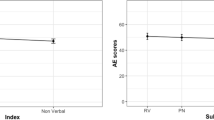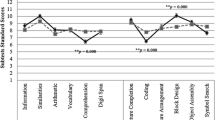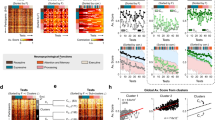Abstract
The aim of the present study was to assess the cognitive profiles of children with autistic spectrum disorder and of their healthy siblings (Siblings). With the term cognitive profile, we indicate the relationship extant among the values of verbal and performance subtests of the Wechsler Intelligence Scale. The conducted statistical analyses indicated that, although siblings showed a normal intelligent quotient and did not differ in this aspect from typically developing group, their cognitive profile was amazingly similar to that of their relatives affected by autism. A k-means clustering analysis on the values of single subtests further confirmed this result, showing a clear separation between typically developing children on the one side, and autistics and their siblings on the other. We suggest that the common cognitive profile observed in autistic children and their siblings could represent a marker of liability to autism and, thus, a possible intermediate phenotype of this syndrome.




Similar content being viewed by others
References
Allen MH, Lincoln AJ, Kaufman AS (1991) Sequential and simultaneous processing abilities of high-functioning autistic and language-impaired children. J Autism Dev Disord 21:483–502
Almasy L, Blangero J (2001) Endophenotypes as quantitative risk factors for psychiatric disease: rationale and study design. Am J Med Genet 105:42–44
American Psychiatric Association (2000) Diagnostic and statistical manual of mental disorders, 4th edn., text revised. American Psychiatric Association, Washington, DC
American Psychiatric Association (2013) Diagnostic and statistical manual of mental disorders, 5th edn. American Psychiatric Publishing, Arlington
Anderberg MR (1973) Cluster analysis for applications. Academic Press, New York
Ankenman K, Elgin J, Sullivan K, Vincent L, Bernier R (2014) Nonverbal and verbal cognitive discrepancy profiles in autism spectrum disorders: influence of age and gender. Am J Intellect Dev Disabil 119:84–99
Asarnow RF, Tanguay PE, Bott L, Freeman BJ (1987) Patterns of intellectual functioning in non-retarded autistic and schizophrenic children. J Child Psychol Psychiatry 28:273–280
August GJ, Stewart MA, Tsai L (1981) The incidence of cognitive disabilities in the siblings of autistic children. Br J Psychiatry 138:416–422
Buitelaar JK, van der Wees M, Swaab-Barneveld H, van der Gaag RJ (1999) Theory of mind and emotion-recognition functioning in autistic spectrum disorders and in psychiatric control and normal children. Dev Psychopathol 11:39–58
Caron MJ, Mottron L, Berthiaume C, Dawson M (2006) Cognitive mechanisms specificity and neural underpinnings of visuospatial peaks in autism. Brain 129:1789–1802
Castelli F (2005) Understanding emotions from standardized facial expressions in autism and normal development. Autism Int J Res Pract 9:428–449
Charman T, Jones CRG, Pickles A, Simonoff E, Baird G, Happé F (2011) Defining the cognitive phenotype of autism. Brain Res 1380:10–21
Constantino JN, Gruber CP (2005) Social Responsiveness Scale (SRS). Western Psychological Services, Los Angeles
Constantino JN, Frazier TW et al (2013) Commentary: The observed association between autistic severity measured by the social responsiveness scale (SRS) and general psychopathology-a response to Hus et al (2013). J Child Psychol Psychiatry 54:695–697
Delorme R, Gousse V, Roy I, Trandafir A, Mathieu F, Mouren-Simeoni MC, Betancur C, Leboyer M (2007) Shared executive dysfunctions in unaffected relatives of patients with autism and obsessive-compulsive disorder. Eur Psychiatry 22:32–38
Dennis M, Lockyer L, Lazenby AL, Donnelly RE, Wilkinson M, Schoonheyt W (1999) Intelligence patterns among children with high-functioning autism phenylketonuria and childhood head injury. J Autism Dev Disord 29:5–17
Ehlers S, Nydén A, Gillberg C, Sandberg AD, Dahlgren SO, Hjelmquist E, Odén A (1997) Asperger syndrome autism and attention disorders: a comparative study of the cognitive profiles of 120 children. J Child Psychol Psychiatry 38:207–217
Folstein SE, Santangelo SL, Gilman SE, Piven J, Landa R, Lainhart J, Hein J, Wzorek M (1999) Predictors of cognitive test patterns in autism families. J Child Psychol Psychiatry 40:1117–1128
Fombonne E, Bolton P, Prior J, Jordan H, Rutter M (1997) A family study of autism: cognitive patterns and levels in parents and siblings. J Child Psychol Psychiatry 38:667–683
Freeman BJ, Ritvo ER, Needleman R, Yokota A (1985) The stability of cognitive and linguistic parameters in autism: a five-year prospective study. J Am Acad Child Adolesc Psychiatry 24:459–464
Freeman BJ, Ritvo ER, Mason-Brothers A, Pingree C, Yokota A, Jenson WR, McMahon WM, Petersen PB, Mo A, Schroth P (1989) Psychometric assessment of first-degree relatives of 62 autistic probands in Utah. Am J Psychiatry 146:361–364
Girardot AM, De Martino S, Chatel C, Da Fonseca D, Rey V, Poinso F (2012) Cognitive profiles in pervasive developmental disorders. Encephale 38:488–495
Gottesman II, Gould TD (2003) The endophenotype concept in psychiatry: etymology and strategic intentions. Am J Psychiatry 160:636–645
Happé FG (1994) Wechsler IQ profile and theory of mind in autism: a research note. J Child Psychol Psychiatry 35:1461–1471
Hughes C, Plumet MH, Leboyer M (1999) Towards a cognitive phenotype for autism: increased prevalence of executive dysfunction and superior spatial span amongst siblings of children with autism. J Child Psychol Psychiatry 40:705–718
Hus V, Bishop S, Gotham K, Huerta M, Lord C (2013a) Commentary: Advancing measurement of ASD severity and social competence: a reply to Constantino and Frazier 2013. J Child Psychol Psychiatry 54:698–700
Hus V, Bishop S, Gotham K, Huerta M, Lord C (2013b) Factors influencing scores on the social responsiveness scale. J Child Psychol Psychiatry 54:216–224
Kaland N, Mortensen EL, Smith L (2007) Disembedding performance in children and adolescents with Asperger syndrome or high-functioning autism. Autism 11:81–92
Kawakubo Y, Kuwabara H, Watanabe K, Minowa M, Someya T, Minowa I, Kono T, Nishida H, Sugiyama T, Kato N, Kasai K (2009) Impaired prefrontal hemodynamic maturation in autism and unaffected siblings. PLoS ONE 4:e6881
Kendler KS, Neale MC (2010) Endophenotype: a conceptual analysis. Mol Psychiatry 15:789–797
Leboyer M, Plumet MH, Goldblum MC, Perez-Diaz F, Marchaland C (1995) Verbal versus visuospatial abilities in relatives of autistic females. Dev Neuropsychol 11:139–155
Lincoln AJ, Courchesne E, Kilman BA, Elmasian R, Allen M (1988) A study of intellectual abilities in high-functioning people with autism. J Autism Dev Disord 18:505–524
Lockyer L, Rutter M (1970) A five- to fifteen-year follow-up study of infantile psychosis. IV. Patterns of cognitive ability. Br J Soc Clin Psychol 9:152–163
Lord C, Rutter M, Goode S, Heemsbergen J, Jordan H, Mawhood L, Schopler E (1989) Autism diagnostic observation schedule: a standardized observation of communicative and social behavior. J Autism Dev Disord 19:185–212
Losh M, Adolphs R, Poe MD, Couture S, Penn D, Baranek GT, Piven J (2009) Neuropsychological profile of autism and the broad autism phenotype. Arch Gen Psychiatry 66:518–526
Mayes SD, Calhoun SL (2003) Analysis of WISC-III, Stanford-Binet: IV and academic achievement test scores in children with autism. J Autism Dev Disord 33:329–341
Minton J, Campbell M, Green WH, Jennings S, Samit C (1982) Cognitive assessment of siblings of autistic children. J Am Acad Child Adolesc Psychiatry 21:256–261
Narita T, Koga Y (1987) Neuropsychological assessment of childhood autism. Adv Biol Psychiatry 16:156–170
Neves MD, Tremeau F, Nicolato R, Lauar H, Romano-Silva MA, Correa H (2011) Facial emotion recognition deficits in relatives of children with autism are not associated with 5HTTLPR. Revista brasileira de psiquiatria 33:261–267
Oerlemans AM, van der Meer JMJ, van Steijn DJ, de Ruiter SW, de Bruijn YGE, de Sonneville LMJ, Buitelaar JK, Rommelse NNJ (2013) Recognition of facial emotion and affective prosody in children with ASD (+ADHD) and their unaffected siblings. Eur Child Adolesc Psychiatry. doi:10.1007/s00787-013-0446-2
Ohta M (1987) Cognitive disorders of infantile autism: a study employing the WISC spatial relationship conceptualization and gesture imitations. J Autism Dev Disord 17:45–62
Orsini L, Picone S (2006) Weschsler Intelligence Scale for Children—III Edizione Italiana Giunti OS, Firenze
Ozonoff S, Pennington BF, Rogers SJ (1991) Executive function deficits in high-functioning autistic individuals: relationship to theory of mind. J Child Psychol Psychiatry 32:1081–1105
Ozonoff S, Rogers SJ, Farnham JM, Pennington BF (1993) Can standard measures identify subclinical markers of autism? J Autism Dev Disord 23:429–441
Pilowsky T, Yirmiya N, Gross-Tsur V, Shalev RS (2007) Neuropsychological functioning of siblings of children with autism, siblings of children with developmental language delay and siblings of children with mental retardation of unknown of genetic etiology. J Autism Dev Disord 37:537–552
Piven J, Palmer P, Jacobi D, Childress D, Arndt S (1997) Broader autism phenotype: evidence from a family history study of multiple-incidence autism families. Am J Psychiatry 154:185–190
Ropar D, Mitchell P (2001) Susceptibility to illusions and performance on visuospatial tasks in individuals with autism. J Child Psychol Psychiatry 42:539–549
Schneider SG, Asarnow RF (1987) A comparison of cognitive/neuropsychological impairments of non retarded autistic and schizophrenic children. J Abnorm Child Psychol 15:29–45
Shah A, Frith U (1993) Why do autistic individuals show superior performance on the block design task? J Child Psychol Psychiatry 34:1351–1364
Siegel DJ, Minshew NJ, Goldstein G (1996) Wechsler IQ profiles in diagnosis of high-functioning autism. J Autism Dev Disord 26:389–406
Szatmari P, Tuff L, Finlayson MA, Bartolucci G (1990) Asperger’s syndrome and autism: neurocognitive aspects. J Am Acad Child Adolesc Psychiatry 29:130–136
Szatmari P, Jones MB, Tuff L, Bartolucci G, Fisman F, Mahoney W (1993) Lack of cognitive impairment in first-degree relatives of children with pervasive developmental disorder. J Am Acad Child Adolesc Psychiatry 32:1264–1273
Venter A, Lord C, Schopler E (1992) A follow-up study of high-functioning autistic children. J Child Psychol Psychiatry 33:489–507
Waldman ID (2005) Statistical approaches to complex phenotypes: evaluating neuropsychological endophenotypes for attention-deficit/hyperactivity disorder. Biol Psychiatry 57:1347–1356
Wechsler D (1974) Manual for the Wechsler Intelligence Scale for Children—revised. Psychological Corporation, New York
Wechsler D (1991) Wechsler Intelligence Scale for Children—third edition manual. Psychological Corporation, New York
Wechsler D (2003) WISC-IV technical and interpretative manual. Psychological Corporation, San Antonio
Acknowledgments
VG, PA and CC were supported by ERC Grant Cogsystem to GR, contract no. 250013. We thank Dr. Fabio Sambataro and Sonia Boria for critical reading and for their remarks on previous versions of the manuscript. A special thanks to the staff of the Pediatric Neuropsychiatry of Empoli, of the rehabilitation center for autism “Centro Mai Soli” in Genova, of the Institute of Rehabilitation “Village Eugenio Litta,” Grottaferrata, Roma, and of the Autism Center of Parma for their invaluable collaboration in data collection. We also thank the staff and families of IV Circolo “Risorgimento - San Berardo” primary school in Teramo for providing the control group. Last but not least, thanks to all the children and their families for the availability and patience.
Author information
Authors and Affiliations
Corresponding author
Rights and permissions
About this article
Cite this article
Gizzonio, V., Avanzini, P., Fabbri-Destro, M. et al. Cognitive abilities in siblings of children with autism spectrum disorders. Exp Brain Res 232, 2381–2390 (2014). https://doi.org/10.1007/s00221-014-3935-8
Received:
Accepted:
Published:
Issue Date:
DOI: https://doi.org/10.1007/s00221-014-3935-8




